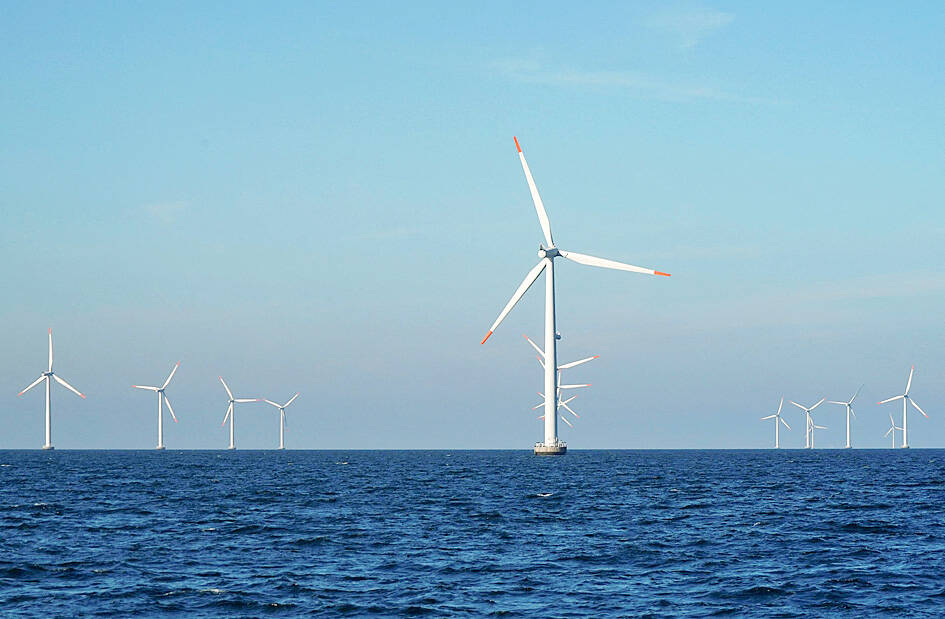Equinor ASA acquired a US$2.5 billion stake in Danish wind energy giant Orsted A/S, pairing one of the Nordic region’s biggest fossil fuel companies with its largest renewable power developer.
The deal with Equinor marks one of the most prominent endorsements of the beleaguered offshore wind industry in years, just as falling interest rates and easing supply chain bottlenecks brighten the outlook for renewable technology key to Europe’s climate goals.
The transaction comes at a critical time for the giant wind developer as Orsted chief executive officer Mads Nipper tries to execute a turnaround plan after the company recorded billions of dollars of write-downs last year due to troubles with offshore wind farms in the US.

Photo: Tom Little, Reuters
“The offshore wind industry is currently facing a set of challenges, but we remain confident in the long-term outlook for the sector, and the crucial role offshore wind will play in the energy transition,” Equinor chief executive officer Anders Opedal said in a statement.
The deal gives Equinor a nearly 10 percent stake in Orsted, making it the second largest shareholder after the Danish government, according to a statement. Equinor doesn’t intend to increase its shareholding any further for now, won’t seek board seats and says it’s supportive of Orsted’s strategy and management.
For Equinor, it’s a simple way to boost its renewable power portfolio. The company has a target of 12 to 16 gigawatts of green power capacity by 2030.
“Equinor gets access to net 1 gigawatt in operating assets for US$2.5 billion, which is similar to the cost of building offshore wind projects – without the risk on construction and delivery, as well as supply chains,” RBC Europe Ltd energy research head Biraj Borkhataria said.
Orsted is trying to claw its way back to growth. Shares soared during the COVID-19 pandemic as rock-bottom interest rates and a frenzy of green investing pushed its market value to nearly US$94 billion in early 2021, just as Nipper took over as CEO. When borrowing costs soared, projects that Orsted was planning to develop looked more expensive forcing the company to write down and exit several sites in the US.
The company canceled two major American projects and fired top executives. Investors fled, sending the company’s shares down so low that Orsted was at one point worth less than the sum of its operating wind farms.
Nipper responded in February with a turnaround plan that axed the company’s dividend, laid off staff and cut its plans to grow this decade. The company has gradually regained value this year, though it’s still worth far less than before the crisis last year.

To many, Tatu City on the outskirts of Nairobi looks like a success. The first city entirely built by a private company to be operational in east Africa, with about 25,000 people living and working there, it accounts for about two-thirds of all foreign investment in Kenya. Its low-tax status has attracted more than 100 businesses including Heineken, coffee brand Dormans, and the biggest call-center and cold-chain transport firms in the region. However, to some local politicians, Tatu City has looked more like a target for extortion. A parade of governors have demanded land worth millions of dollars in exchange

Hong Kong authorities ramped up sales of the local dollar as the greenback’s slide threatened the foreign-exchange peg. The Hong Kong Monetary Authority (HKMA) sold a record HK$60.5 billion (US$7.8 billion) of the city’s currency, according to an alert sent on its Bloomberg page yesterday in Asia, after it tested the upper end of its trading band. That added to the HK$56.1 billion of sales versus the greenback since Friday. The rapid intervention signals efforts from the city’s authorities to limit the local currency’s moves within its HK$7.75 to HK$7.85 per US dollar trading band. Heavy sales of the local dollar by

Taiwan Semiconductor Manufacturing Co’s (TSMC, 台積電) revenue jumped 48 percent last month, underscoring how electronics firms scrambled to acquire essential components before global tariffs took effect. The main chipmaker for Apple Inc and Nvidia Corp reported monthly sales of NT$349.6 billion (US$11.6 billion). That compares with the average analysts’ estimate for a 38 percent rise in second-quarter revenue. US President Donald Trump’s trade war is prompting economists to retool GDP forecasts worldwide, casting doubt over the outlook for everything from iPhone demand to computing and datacenter construction. However, TSMC — a barometer for global tech spending given its central role in the

The Financial Supervisory Commission (FSC) yesterday met with some of the nation’s largest insurance companies as a skyrocketing New Taiwan dollar piles pressure on their hundreds of billions of dollars in US bond investments. The commission has asked some life insurance firms, among the biggest Asian holders of US debt, to discuss how the rapidly strengthening NT dollar has impacted their operations, people familiar with the matter said. The meeting took place as the NT dollar jumped as much as 5 percent yesterday, its biggest intraday gain in more than three decades. The local currency surged as exporters rushed to